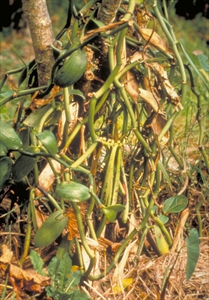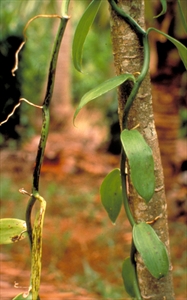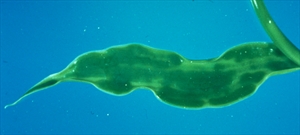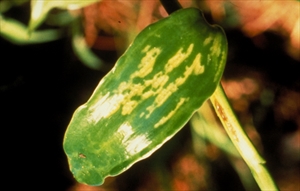Vanilla virus diseases
Pacific Pests, Pathogens, Weeds & Pesticides - Online edition
Pacific Pests, Pathogens, Weeds & Pesticides
Vanilla viruses (159)
Cymbidium mosaic virus (CymMV), Odontoglossum ringspot virus (ORSV), Watermelon mosaic virus - Vanilla necrosis virus strain (WMV-VNS), Vanilla mosaic virus (VaMV).
CymMV and ORSV are found worldwide in vanilla and other orchids; WMV-VNV has only been recorded in vanilla from the Pacific; it is present in Cook Islands, Fiji, French Polynesia, and Tonga; VaMV has been recorded from vanilla in Cook Islands, Fiji, French Polynesia, and Vanuatu.
CMV and ORSV are found in vanilla and ornamental orchids worldwide; WMV-VNV is a vanilla strain of Watermelon mosaic virus, and has only been recorded from vanilla. VaMV has been recorded only from vanilla (Vanilla planifolia and Vanilla tahitensis ).
Plants infected with CymMV and ORSV show faint yellow patches on young leaves, with wavy, distorted surfaces and edges. Plants with WMV-VNV (Photos 1&2) and VaMV (Photos 3&4) also show irregular, yellow patches and streaks on young distorted leaves, but as they age, scab-like dark spots develop on the leaves and long black areas on the stems. Rapid dieback occurs, leading to death of the plants. Symptoms are more severe if different types of viruses occur together in a single plant.
The viruses are spread in several ways. CymMV and ORSV are spread on pruning tools; VaMV and WMV-VNV are spread this way, but also by aphids. The aphids become infected as they feed on diseased plants, and then pass the virus to healthy plants with their next feed. Another common way for the viruses to be spread is in infected cuttings used for propagation; this is an important method of spread.
CymMV and ORSV are commonly found in vanilla, but damage is slight. By contrast, WMV-VNV causes serious production losses. Surveys in Fiji and Tonga found that most plantations had the virus, and the overall average was 56% and 80% for these countries, respectively. Infected plants dieback and are dead within 3-12 months from the time that symptoms are first seen and since replacement vines take approximately 4 years to start producing significant quantities of beans, the disease can have a major effect on production.
Losses from VaMV are much less (Photos 3&4): damage to individual plants is similar to that caused by WMV-VNV, but spread is low and the impact is low.
Look for yellow patches and streaks on young leaves with wavy margins. Look to see dark spots on the leaves as they age. Look to see long black areas on the stems, rapid vine dieback and death. It is difficult to identify these virus diseases on symptoms alone, and for accurate identification analysis using antisera is required. If vanilla vines start to die back with scab-like spots on distorted leaves it is likely that either WMV-VNV or VaMV or both are present.
CULTURAL CONTROL
Cultural control is particularly important in the management of these diseases:
- Weeds: Crops should be kept free of weeds that are hosts to aphids.
- Pruning: Take care when pruning vines and/or training the vines around their support trees. The sap may contain viruses. Hands should be frequently washed with soap and water, and pruning tools and knives should be surface-sterilised in bleach, or placed in boiling water for 5 minutes.
- Hygiene: Remove plants at the first sign of symptoms of any of these viruses. Take the plants out of the plantation and burn or bury them.
- Cuttings for planting: Take cuttings from healthy, fast growing plants. NEVER use cuttings from diseased plants, even if part of the plant looks healthy. It is best to take cuttings only from plantations that have never shown signs of the diseases.
- Tissue cultures: Note, the CePaCT lab Secretariat of the Pacific Community has virus-tested, sterile plants growing in tissue culture for distribution to member countries. These should be grown in an aphid-proof facility and cuttings taken from them for propagation if no other source of healthy cuttings is available.
RESISTANT VARIETIES
There is no known resistance in Vanilla planifolia or Vanilla tahitensis to these diseases.
CHEMICAL CONTROL
Chemical control is not appropriate for these diseases. There are insecticides that can kill aphids, but they cannot kill them before they have fed and infected the plants with virus.
AUTHOR Grahame Jackson
Information from CABI (2013) Vanilla mosaic virus (https://www.cabi.org/cpc/datasheet/56579), Watermelon mosaic virus-II (https://www.cabi.org/cpc/datasheet/56580), Cymbidium mosaic virus (https://www.cabi.org/cpc/datasheet/14368), Odontoglossum ringspot virus (https://www.cabi.org/cpc/datasheet/37054). Crop Protection Compendium; and from Pearson MN, et al. (1993) Vanilla viruses in the South Pacific. Plant Pathology 42(1): 127-131. (DOI:10.1111/j.1365-3059.1993.tb01479.x) and from Jackson GVH, Pearson MN (1991) Virus diseases of vanilla in Fiji. Suva, Fiji: Fiji Ministry of Primary Industries. Photos 1-3 Mike Pearson, University of Auckland, New Zealand. Photos 3 Bill Zettler, University of Florida, USA.
Produced with support from the Australian Centre for International Agricultural Research under project PC/2010/090: Strengthening integrated crop management research in the Pacific Islands in support of sustainable intensification of high-value crop production, implemented by the University of Queensland and the Secretariat of the Pacific Community.







